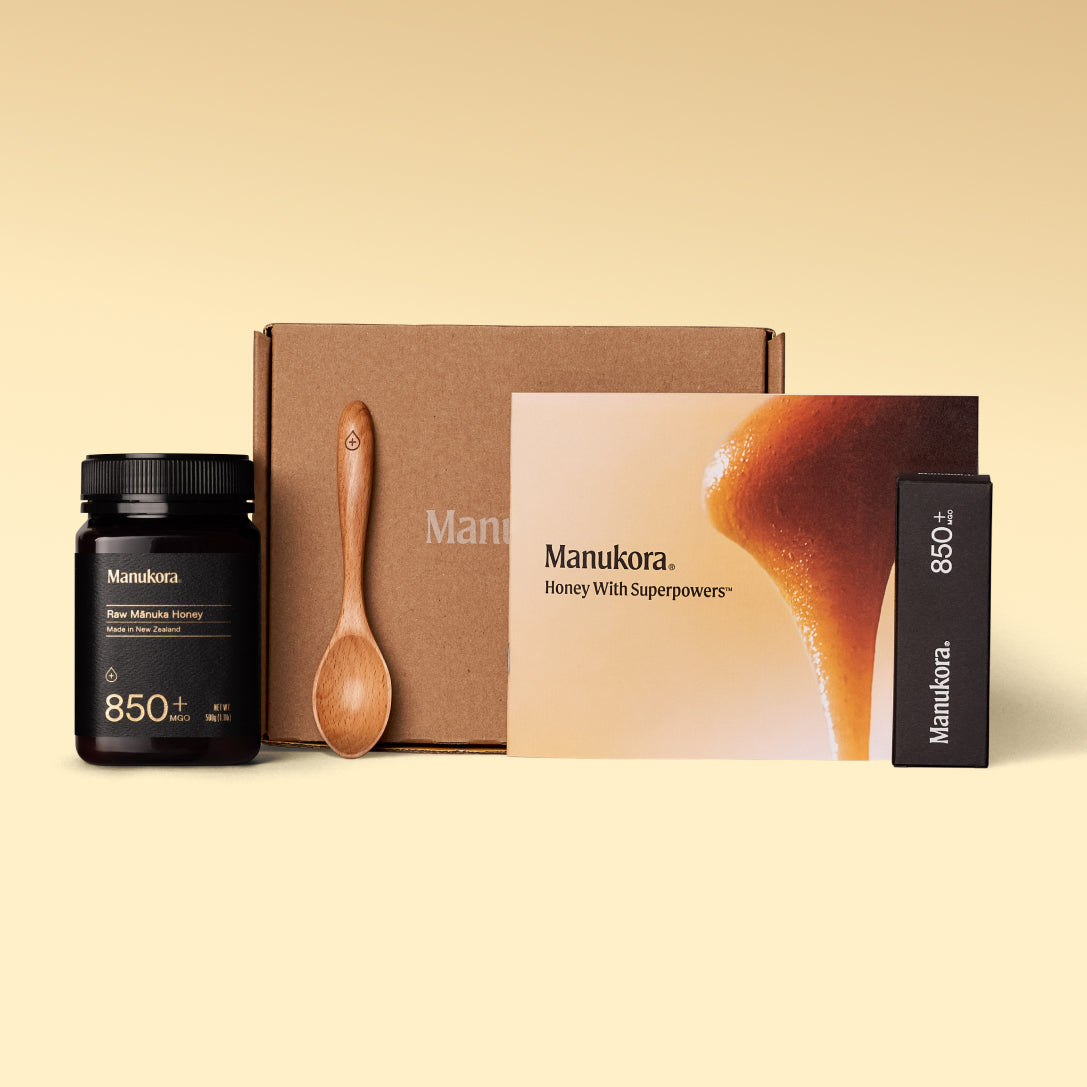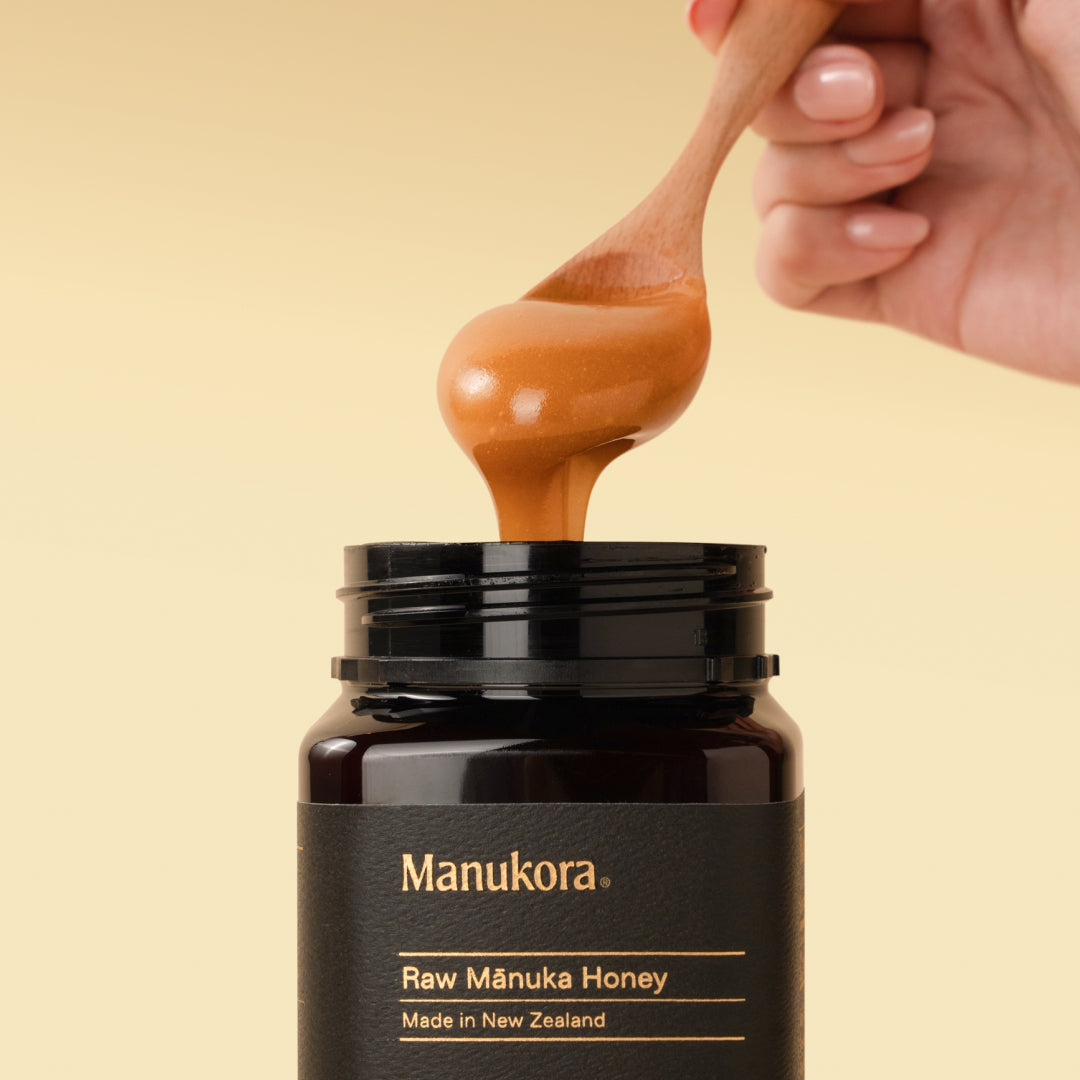Executive Summary:
-
Bees ensure the survival of thousands of flowering plants through the transferring of pollen—pollen which also influences the flavor of their honey.
-
Different species of bees exhibit different pollination behaviors, resulting in variations in the flavor—and composition—of regional honey.
-
The nectar and pollen that the bees collect directly influence the flavor of the honey— which often bears similar tastes or hints of the plant it was derived from.
-
Sustainable beekeeping and flora conservation are key to preserving natural, high-quality honey production as they directly support the health of bees.
How Bees Shape Honey's Flavor: A Pollinator Study
Did you know that there are more than 20,000 species of bees, but less than 800 species produce honey? While not all bees are honey producers, they are all incredibly important.
Without bees, plant species would become extinct, human nutrition would take a massive hit, and ecosystems, as we know them, would disintegrate. Isn't it amazing how one small insect can support so much life? So, let's dive into understanding more about our busy and buzzing friends—specifically the pollinators.
The art and science of honey is written in the wings of bees, carried in their pollen baskets, and expressed in the unique flavor profiles they create - a living testament to the biodiversity of our planet.
Understanding Bee Pollination
Honeybees are an essential part of our ecosystem. As a flower gently unfurls, honey bees detect the sweet aroma of its nectar from far away. As they draw closer, they're attracted to the vibrant colors of the petals—white, blue, yellow, violet.
Then, through their busy work of drinking nectar (energy source) and taking in pollen (protein and nutrients) to produce honey for their colonies, bees unknowingly collect surplus pollen from the male part of the plant (anthers). Their fuzzy legs are perfect for holding onto the pollen, ready to transport it to the female part (stigma) of the next flower. This results in fertilization—and the survival of countless flowering plants!
There are thousands of species of bees, so it's not surprising that they exhibit different pollination behaviors while feasting on the rich nectar of blossoms. These behaviors and foraging differences can lead to variations in the composition of the honey. Some key differences and interesting facts include:
-
Some bees spend longer foraging than others—consuming more pollen as a result.
-
Others have larger bodies that can naturally hold onto more pollen.
-
Some bees travel further between flowers than others - enjoying a wider variation of nectar and pollen.
-
Honey bees and "non-honey" bees have different preferences of nectar—making both essential for the pollination of the different plant species.
While pollination behavior does affect the flavor of the honey, the greatest influence is the nectar that the honey bees feast on.
Pollination Process: From Flower to Hive
The journey from flower nectar to honey jar involves several fascinating steps that directly influence the final flavor profile:
-
Nectar Collection: Bees extract nectar from flowers using their long proboscis (tongue)
-
Initial Processing: Enzymes in the bee's honey stomach begin breaking down complex sugars
-
Hive Transfer: Returning forager bees regurgitate nectar to house bees
-
Enzymatic Action: House bees further process the nectar with additional enzymes
-
Water Reduction: Bees fan their wings to reduce moisture content from about 80% to 17-18%
-
Cell Storage: Processed honey is stored in honeycomb cells and capped with beeswax
Each step in this process can subtly affect the taste, texture, and properties of the resulting honey. The specific enzymes added by different bee species can create distinctive flavor notes even when collecting from identical floral sources.
Floral Sources and Honey Flavor
Just like fingerprints are unique, so is each nectar and the honey that results. In fact, in many cases, it's possible to identify the source flora based on the flavor profile of the honey alone.
So, let's take a closer look at some of the famous flavor profiles of honey from all over the world—how many have you tried?
-
Clover Honey: Abundant in America, this clear amber honey is light and sweet with a flowery flavor thanks to the sweet aroma of the blossoms.
-
Dandelion Honey: This sharp, strong honey has an aroma similar to the plant it is derived from.
-
Eucalyptus Honey: This honey is slightly salty with undertones of menthol and earthiness.
-
Manuka Honey: This distinct caramel-like honey might not taste like the Manuka tea tree, but it certainly embodies its natural, antibacterial properties.
-
Orange Blossom Honey: This light honey has sweet citrus scents, no doubt, due to the nectar it stems from.
-
Wildflower Honey: Wildflower honey is usually earthy, floral, and fruity in flavor, with delicate notes that reflect the flavor of the nectar.
Honey Flavor Profiles: A Global Tasting Guide
|
Honey Variety |
Primary Floral Source |
Region |
Color |
Flavor Profile |
Texture |
|
Manuka |
Leptospermum scoparium (Manuka bush) |
New Zealand |
Amber to dark brown |
Rich, caramel-like with woody notes |
Creamy, thick |
|
Clover |
Trifolium (Clover) |
North America, New Zealand |
Light amber |
Mild, floral, slightly sweet |
Smooth |
|
Orange Blossom |
Citrus sinensis |
California, Florida, Mediterranean |
Very light amber |
Citrusy, delicate, aromatic |
Fluid |
|
Eucalyptus |
Eucalyptus spp. |
Australia |
Medium amber |
Bold, slightly medicinal, menthol notes |
Medium-thick |
|
Lavender |
Lavandula |
France, Spain |
Pale amber |
Floral, herbal, distinctive |
Light, smooth |
|
Buckwheat |
Fagopyrum esculentum |
Russia, Canada, USA |
Dark brown to purple |
Strong, malty, molasses-like |
Thick |
|
Acacia |
Robinia pseudoacacia |
Europe, North America |
Almost clear |
Very mild, vanilla notes |
Runny, slow to crystallize |
|
Leatherwood |
Eucryphia lucida |
Tasmania |
Amber |
Spicy, aromatic, balsamic |
Medium-thick |
This diversity of flavor profiles demonstrates how the relationship between bee species, local flora, and regional environmental factors creates unique honey expressions around the world.
The Special Relationship Between Bees and Manuka Trees
The story of Manuka honey begins with a special relationship between the Manuka tea tree (Leptospermum scoparium) and the European honey bee (Apis mellifera). Although the European honey bee is not native to New Zealand, it has adapted perfectly to collect nectar from the native Manuka trees.
What makes this relationship particularly interesting is the timing and conditions required:
-
Manuka trees flower for only 2-6 weeks per year
-
Weather conditions must be ideal during this brief window
-
Bees must be healthy and strong to collect enough nectar
-
Hives must be strategically placed in remote Manuka forests
This delicate balance explains why genuine Manuka honey is relatively rare and precious. The bees must work quickly during the flowering season, and beekeepers must time their hive placements perfectly to ensure the honey produced is predominantly from Manuka nectar.
At Manukora, we track the flowering patterns across different regions of New Zealand and carefully position our hives to optimize pure Manuka honey production, resulting in our premium MGO-rated honey varieties.
Regional Bee Species and Local Honey Varieties
Different bees prefer different nectars, and not all bees can produce the same quality of honey. An interesting study on African stingless bees highlights that some bees produce superior honey (more intense nutrient profile) from the same nectar than other species.
While ongoing studies will no doubt reveal more, it's clear that certain bee species thrive and produce superior honey in specific regions. By carefully studying and protecting local bee populations and their natural foraging grounds around the world, we can preserve the wide variety of natural and nutrient-rich honey that results—while ensuring the lifecycle of the indigenous vegetation they depend on.
Each jar of honey is a geographic and botanical autobiography - telling the story of a specific place, its plants, and the remarkable creatures that connect them all.
The Impact of Bee Health on Honey Quality
Healthy bees equate to high-quality honey.
The greatest investment in the quality of honey that is produced is the health of the bees that produce it. Bee health is completely dependent on the nutrition (nectar and pollen) available to the bees.
Without adequate nutrition, bees suffer from reduced immunity and fall victim to a variety of pathogens and pesticides. As a result of reduced resiliency, the social structure of the colony is broken down, the colony is weakened, and the quality and quantity of honey drops as the colony dies.
Current challenges that threaten the health of the bees include:
-
Habitat loss—reduced natural flora due to development
-
Increased presence of pesticides on flora that feed the bees
-
The spread of parasites across the world due to the transportation of bee colonies
Climate Change and Its Effect on Honey Production
Climate change is creating new challenges for bees and honey production worldwide:
-
Shifting Flowering Seasons: As temperatures change, flowering times become unpredictable, disrupting the natural synchronization between bees and plants
-
Extreme Weather Events: Droughts, floods, and unseasonable frosts can damage nectar sources and impact bee foraging patterns
-
Changing Plant Distribution: Native plant ranges are shifting, altering the available nectar sources for regional bee populations
-
Water Stress: Plants under water stress produce less nectar, affecting both honey quantity and quality
These factors are increasingly affecting honey flavor profiles around the world. At Manukora, we're monitoring these changes closely and adapting our beekeeping practices to support our bees through these environmental challenges while maintaining the distinctive quality of our Manuka honey.
Conservation Efforts and Sustainable Beekeeping
The general health of bees is a global concern. Thankfully, there are ways to protect and preserve the natural and intricate balance of the bees and their foraging grounds—without introducing chemicals or drugs.
Conserve their Habitat
The most effective way to conserve bee populations is to preserve their nutrition by protecting their natural habitat as far as possible. Individuals can make a positive impact by growing indigenous flowering plants in their gardens or on their balconies to support the local bees.
Sustainable Beekeeping
Sustainable beekeeping is the careful balance of gathering honey from healthy hives without compromising the health or future well-being of the bees. It involves:
-
Removing honey while still leaving plenty for the bees—especially through the winter
-
Minimal disturbance of the hive—little movement, no additives, etc.
-
Chemical-free care—avoiding the use of antibiotics
Through the thoughtful and gentle process of sustainable beekeeping, our generation is looking ahead to the next. Taking care of the bees today will allow our children's children to enjoy the diverse and wonderful variations of high-quality honey found all over the world.
The intricate dance of the flowers and the bees is reflected in the delightful and surprising array of natural honey enjoyed globally. The natural variety of flavors is a reminder of the diverse and valuable flora that nourishes and sustains the bees—and ourselves.
Manukora's Approach to Sustainable Beekeeping
At Manukora, our beekeeping practices honor the natural rhythms of the hive while supporting optimal honey production:
-
Hive Placement: We carefully position our hives in remote areas with abundant Manuka growth, far from agricultural pesticides
-
Minimal Intervention: We disturb our hives only when necessary, respecting the bees' natural cycles
-
No Artificial Feeding: Our bees feed on their own honey reserves rather than sugar substitutes
-
Harvest Timing: We wait until honey is fully ripened before harvesting, ensuring optimal composition
-
Winter Reserves: We leave sufficient honey stores for the colony during winter months
-
Chemical-Free Management: We avoid antibiotics and synthetic treatments
These practices result in healthier bees, higher quality honey, and a sustainable approach that preserves New Zealand's unique Manuka resources for future generations.
Conclusion: The Symphony of Bees, Flowers, and Flavor
The story of honey is ultimately a story of relationship—between bees and flowers, between ecosystems and climate, between traditional knowledge and modern science. Like a master perfumer creating a signature scent, bees craft unique honey varieties through their particular foraging patterns, enzymatic processes, and interactions with local flora.
What we taste in a spoonful of honey is the culmination of millions of years of co-evolution between plants and their pollinators. Each honey variety represents a snapshot of a specific place and time, captured through the remarkable alchemy that occurs within the hive.
The distinctive caramel notes of Manuka honey, the citrus brightness of orange blossom honey, or the rich complexity of wildflower varieties—each tells the story of the landscape from which it emerged.
When we protect our pollinators, we're not just saving honey—we're preserving one of nature's most exquisite expressions of biodiversity, captured in liquid gold.
Frequently Asked Questions
How does the species of bee affect honey flavor?
Different bee species have varying enzymes in their honey stomachs that process nectar differently. These enzymes can subtly alter the chemical composition of honey, affecting both flavor and texture. Additionally, different bee species have preferences for certain flowers, influencing the blend of nectars that become their honey.
Why does Manuka honey taste different from other types?
Manuka honey's distinctive flavor comes from the unique compounds found in the nectar of the Manuka tea tree (Leptospermum scoparium), which is native to New Zealand. The levels of methylglyoxal (MGO) and other compounds contribute to its rich, caramel-like taste with woody undertones.
Can you taste the difference between honey made by different bee species from the same flowers?
Yes, honey connoisseurs can often detect subtle differences. For example, honey from European honey bees (Apis mellifera) typically has different flavor notes than honey from stingless bees (Meliponini) even when they've visited the same flowers, due to different enzymatic processing and honey maturation.
How does the environment impact honey flavor beyond the flowers?
Environmental factors like soil composition, altitude, temperature, and humidity can all influence the nectar composition of flowers. Bees from the same species collecting nectar from identical plant species in different regions may produce honey with noticeably different flavor profiles due to these environmental variables.
What makes monofloral honey (like Manuka) different from polyfloral honey?
Monofloral honey comes primarily from a single type of flower, giving it distinctive characteristics associated with that plant. Polyfloral honey (sometimes called wildflower honey) comes from many different flower sources, creating a more complex but often less distinctive flavor profile that may change significantly from season to season.
Sources:
What Do You Really Know About Bees? - MSU
Different Pollinators' Functional Traits Can Explain Pollen Load in Two Solitary Oil-Collecting Bees - NIH


















